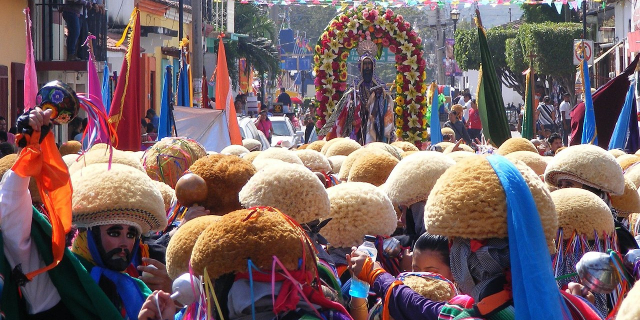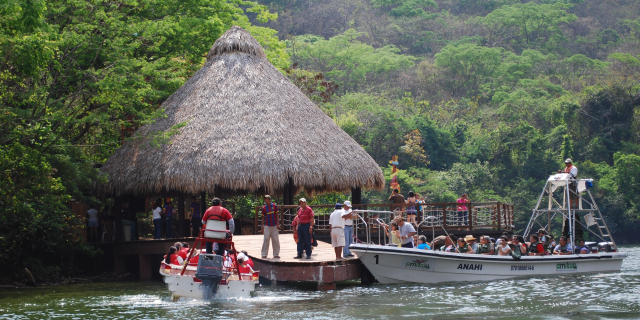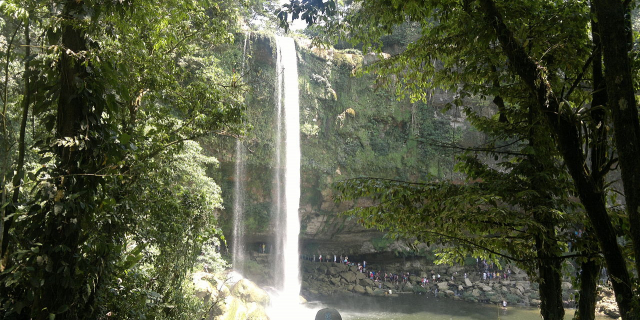San Cristóbal de Las Casas
( San Cristóbal de las Casas )San Cristóbal de las Casas (Spanish: [saŋkɾisˈtoβal de las ˈkasas] ), also known by its native Tzotzil name, Jovel (pronounced [xɤ̞ˈve̞l]), is a town and municipality located in the Central Highlands region of the Mexican state of Chiapas. It was the capital of the state until 1892, and is still considered the cultural capital of Chiapas.
The municipality is mostly made up of mountainous terrain, but the city sits in a small valley surrounded by hills. The city’s center maintains its Spanish colonial layout and much of its architecture, with red tile roofs, cobblestone streets and wrought iron balconies often with flowers. Most of the city’s economy is based on commerce, services and tourism.
Tourism is based on the city’s hi...Read more
San Cristóbal de las Casas (Spanish: [saŋkɾisˈtoβal de las ˈkasas] ), also known by its native Tzotzil name, Jovel (pronounced [xɤ̞ˈve̞l]), is a town and municipality located in the Central Highlands region of the Mexican state of Chiapas. It was the capital of the state until 1892, and is still considered the cultural capital of Chiapas.
The municipality is mostly made up of mountainous terrain, but the city sits in a small valley surrounded by hills. The city’s center maintains its Spanish colonial layout and much of its architecture, with red tile roofs, cobblestone streets and wrought iron balconies often with flowers. Most of the city’s economy is based on commerce, services and tourism.
Tourism is based on the city’s history, culture and indigenous population, although the tourism itself has affected the city, giving it foreign elements. Major landmarks of the city include the Cathedral, the Santo Domingo church with its large open air crafts market and the Casa Na Bolom museum. The municipality has suffered severe deforestation, but it has natural attractions such as caves and rivers.
 Del Carmen Arch
Del Carmen ArchThe city was founded as Villa Real de Chiapa in 1528 by Diego de Mazariegos in what was called the Hueyzacatlán Valley, which means “pasture” in Nahuatl. From then on, the city went through a number of name changes: to Villa Viciosa in 1529, to Villa de San Cristóbal de los Llanos in 1531, and to Ciudad Real in 1536. It was changed to Ciudad de San Cristóbal in 1829. “de las Casas” was added in 1848 in honor of Bartolomé de las Casas. There were some modifications in the early 20th century to the name but it returned to San Cristóbal de las Casas in 1943.[1] In the Tzotzil and Tzeltal languages the name of the area is Jovel, “the place in the clouds”.[2]
The area did not have a pre-Hispanic city. After defeating the Zoques in the Northern Mountains and the Chiapans of this area, Diego de Mazariegos founded the city as a military fort. This city and much of what would be the state of Chiapas came under the Captaincy General of Guatemala in 1532 headed by Pedro de Alvarado. San Cristóbal received its coat of arms in 1535 from Carlos V and it was officially declared a city in 1536. The city gained the rank of Alcadía Mayor in 1577 which gave it authority over much of Chiapas north of it. The intendencia of Chiapas was created in 1786 combining San Cristóbal’s territory with that of Tuxtla and Soconusco, with the government in San Cristóbal. In 1821, the city followed the Comitán de Domínguez’ declaration of independence from Spain and the Captaincy General of Guatemala. However, the city and the rest of Chiapas became a part of Mexico in 1824, with the capital established here.[1]
In 1829, the name Ciudad Real was changed to San Cristóbal. In the 19th century, the state government would shift back and forth between San Cristóbal, in the highlands dominated by Conservatives, and Tuxtla, dominated by Liberals. Independent tendencies arose again in 1853, when the Plan of Yalmús was announced declaring the then Mexican Constitution null. Conservative forces attacked the city in 1857 but were dislodged shortly thereafter by Liberal Angel Albino Corzo. The last of French forces were expelled from the city in 1864. The state government was moved from San Cristóbal to Tuxtla for good in 1892 by the Liberal government.[1] There was a failed attempt in 1911 by Conservatives in San Cristóbal and neighboring San Juan Chamula to force the return of the capital.[3]
In 1915, the state went to the municipality system with San Cristóbal becoming a municipality. Originally, it had jurisdiction over communities such as San Lucas, Zinacantán, San Felipe Ecatepec, Tenejapa, San Miguel Mitontic, Huixtan and Chanal, but these would later separate to become municipalities in their own right.[1] In the 20th century, the outskirts of the city become filled with open pit mines for gravel and sand. There was even one opened on a hill in the San Diego and La Florecilla neighborhoods, near the historic center called Salsipuedes. These prompted environmental and local community organizations to protest, stating that the valley is a closed water basin and the mining negatively affects potable water supplies. Salsipuedes was closed in the 2000s.[4]
The city was declared a national historic monument in 1974.[4]
 EZLN flag
EZLN flagSan Cristóbal became the center of political activism with the election of Samuel Ruiz as bishop of Chiapas in 1960. In the 1960s and 1970s, the traditional Catholic Church was losing indigenous adherents to Protestant and other Christian groups.[5] To counter this, Ruiz supported and worked with Marist priests and nuns following an ideology called liberation theology. In 1974 he organized a statewide Indian Congress with representatives from 327 communities of the Tzeltal, Tzotzil, Tojolabal and Ch'ol peoples as well as Marists and the Maoist People’s Union. This congress was the first of its kind with the goal of uniting the indigenous peoples politically. These efforts were also supported by leftist organizations from outside Mexico, especially to form unions of ejido organizations. These unions would later form the base of the EZLN organization.[6] These efforts would also create a “new” type of Catholic in the state called “Word of God” Catholic. These would shun the “traditionalist” Catholic practice mixed with indigenous rites and beliefs. It would also create a split in many communities as the “Word of God” Catholics were loyal directly to the bishop in San Cristóbal, with traditionalists loyal to local cacique leaders.[7]
Activism and resentment continued from the 1970s to the 1990s. During this decade, the Mexican federal government adopted neoliberalism, which clashed with the leftist political ideas of liberation theology and many of the indigenous activist groups.[6] Despite the activism, economic marginalization among indigenous groups remained high, with resentment strongest in the San Cristóbal region and in migrant communities living in the Lacandon Jungle.
The grievances of these activists would be taken up by a small guerrilla band led by a man called only “Subcomandante Marcos.”[8] His small band, called the Zapatista Army of National Liberation (Ejército Zapatista de Liberación Nacional, EZLN), came to the world’s attention when on January 1, 1994, the day the NAFTA treaty went into effect. On this day, EZLN forces occupied and took over the towns of San Cristóbal de las Casas, along with six other Chiapas communities. They read their proclamation of revolt to the world and then laid siege to a nearby military base, capturing weapons and releasing many prisoners from the jails.[9] Ruiz negotiated between the EZLN and authorities even though his leftist activism made him suspect to many authorities. This would undermine efforts and eventually the Catholic Church would split from the Zapatista movement.[5][7] However, the negotiations would lead to the San Andrés Accords and ended the rebellion peacefully. By the time he died in 2011, Ruiz was locally given the name of “Tatic”, which means “father” in Tzotzil, and received numerous distinctions including the Simón Bolívar Prize from UNESCO and the International Human Rights Award in Nuremberg.[10]





























Add new comment